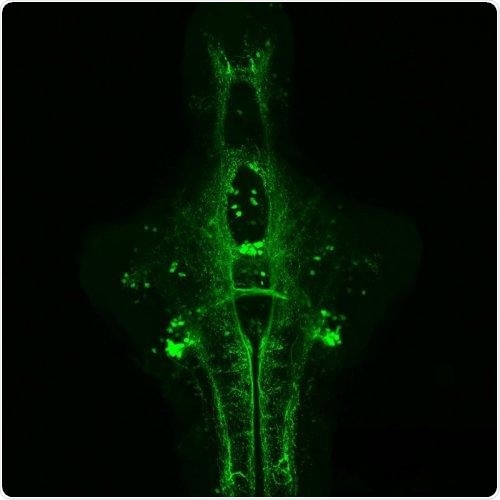The speed at which a person runs determines the end result, whether running to win Olympic gold or to escape a predator.
Locomotion occurs when limb muscles contract in an aligned manner, taking place due to electrical impulses discharged by nerve cells, called motor neurons, that are found in the spinal cord.

Dopamine in zebrafish increases the activity of motor neurons in the spinal cord, and this translates into faster swimming bouts in response to visual stimulation. Image Credit: Vatsala Thirumalai.
Previous studies have shown that brain circuits choose an appropriate action and set the frequency of motion depending on an animal’s temporary requirements. Then, spinal “speed” modules are selectively triggered to attain a specific speed level, quite similar to how gears are engaged in an automobile.
Thus, motor neurons related to the fast module are triggered only at the time of fast frequency movements, but they remain inactive during slower frequency movements.
At present, researchers at the National Centre for Biological Sciences (NCBS), Bangalore, demonstrate that the ability of animals to run faster arises from parallel neural pathways that tend to bypass the brain’s stringent frequency control.
As part of the research, the scientists desired to study speed control in larval zebrafish in the course of a reflex behavior called an optomotor response.
Such behavior enables zebrafish to maintain a stable position in streams by producing swimming actions to tackle any drift. The team reproduced this behavior in the laboratory by playing black and white moving bars, or gratings, on a screen positioned below the fish.
Although the larvae were trapped on a dish to enable the quantification of electrical activity from motor neurons, they could still respond to the visual stimulus in a reliable way by generating motor commands for swimming. This preparation enabled the investigation of the mechanisms of speed control at a single-cell level.
Dopamine—a chemical synthesized by certain nerve cells—is released at various sites, including motor neurons. The NCBS researchers found that triggering the receptors for dopamine made the zebrafish larvae to swim faster for the same grating stimulus.
A detailed analysis revealed that larvae could swim faster because, for each tail beat, the tail created larger amplitude bends. This shows that more motor neurons were triggered to achieve faster swims.
The researchers recorded the electrical activity of single motor neurons and observed that apart from the slow speed module triggered more vigorously following dopamine receptor activation, fast module motor neurons, which were inactive so far, were also triggered. This was due to the direct influence of dopamine on the motor neurons, causing the motor neurons to be excitable.
The study outcomes are fascinating as they demonstrate that motor neurons, which are considered to mainly only relay the command that they receive, have the potential to alter behavioral output by modulating their activity patterns.
The research reveals that despite the command given by the brain for a movement, modification of the properties of motor neurons can change the final behavioral outcome. The corresponding motor neuronal plasticity can be leveraged for rehabilitation following stroke or injury to the spinal cord.
Source:
Journal reference:
Jha, U. & Thirumalai, V., (2020) Neuromodulatory Selection of Motor Neuron Recruitment Patterns in a Visuomotor Behavior Increases Speed. Current Biology. doi.org/10.1016/j.cub.2019.12.064.